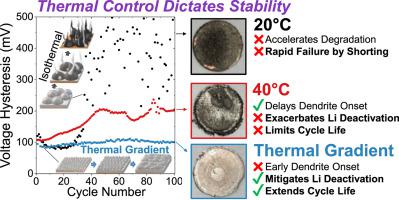Materials Today Energy ( IF 9.0 ) Pub Date : 2020-09-16 , DOI: 10.1016/j.mtener.2020.100538 Robert W. Atkinson , Todd A. Kingston , Emily Klein , Addison NewRingeisen , Rachel Carter , Corey T. Love

|
The reversibility of Li electrodeposits must be significantly improved for Li metal anodes to be realized for next-generation, high energy density batteries. The most commonly tested thermal condition in the Li metal battery literature is isothermal ~20 °C (ambient). Elevating the cell temperature (40 °C) improves Li metal stability by suppressing dendritic growth at the expense of augmenting solid electrolyte interphase growth. However, at the high current density and areal capacity tested in this work (10 mA cm−2, 3.0 mA h cm−2), dendritic growth is inevitable and Li metal electrodes succumb to extensive degradation due to Li deactivation. To overcome these shortcomings of isothermal cycling, we expand on our concept of an interelectrode thermal gradient, which enhances Li surface diffusion to homogenize Li electroplating. With mean temperatures near ambient, a thermal gradient (ΔTwarm: 22.6 °C negative electrode, 21.4 °C positive electrode) delays failure compared with isothermal control (20 °C). The greatest benefit of the thermal gradient is unlocked at sub-ambient electrode temperatures. By applying the thermal gradient at low temperatures (ΔTcold: 3.7 °C negative electrode, 2.0 °C positive electrode), SEI growth stifles, dendrite propagation suppresses, and Li deactivation minimizes, stabilizing high-rate Li electroplating and stripping. After 100 cycles, ΔTcold reduces voltage hysteresis and electrode resistance by 51% and 77%, respectively, compared with the most promising isothermal condition (40 °C). Operando optical visualization confirms more reversible and dense Li electrodeposition via sub-ambient thermal gradient control with higher first-cycle Coulombic efficiency in an anode-free configuration. By contrast, isothermal 20 °C control exacerbates porous and dendritic Li electrodeposition with low reversibility.
中文翻译:

通过亚环境温度梯度控制,在高速率电镀过程中将锂失活降至最低
锂电沉积物的可逆性必须得到显着改善,以实现下一代高能量密度电池的锂金属阳极。锂金属电池文献中最常测试的热工条件是约20°C(环境温度)。升高电池温度(40°C)可通过抑制树枝状晶体的生长来提高锂金属的稳定性,但以增加固态电解质相间生长为代价。但是,在这项工作中测试的高电流密度和面容量下(10 mA cm -2,3.0 mA h cm -2),不可避免地会出现树枝状生长,并且由于Li失活,Li金属电极会大量降解。为了克服等温循环的这些缺点,我们扩展了电极间热梯度的概念,该概念可增强锂表面扩散以使锂电镀均匀化。在平均温度接近环境温度的情况下,与等温控制(20°C)相比,温度梯度(ΔT温暖:22.6°C负极,21.4°C正极)可延迟故障。在低于环境温度的电极温度下,热梯度的最大优势得以释放。通过在低温下施加热梯度(ΔT冷:3.7°C负极,2.0°C正极),SEI生长受阻,枝晶传播受到抑制,并且Li失活最小化,稳定了高速率的Li电镀和剥离。100次循环后,ΔT冷由分别为51%和77%,用最有前途的等温条件(40℃)相比,降低了电压滞后和电极电阻,。Operando光学可视化技术通过在无阳极配置下具有较高的第一循环库伦效率的亚环境热梯度控制,证实了可逆和致密的锂电沉积。相比之下,等温20°C的控制会加剧可逆性低的多孔和树枝状Li电沉积。










































 京公网安备 11010802027423号
京公网安备 11010802027423号